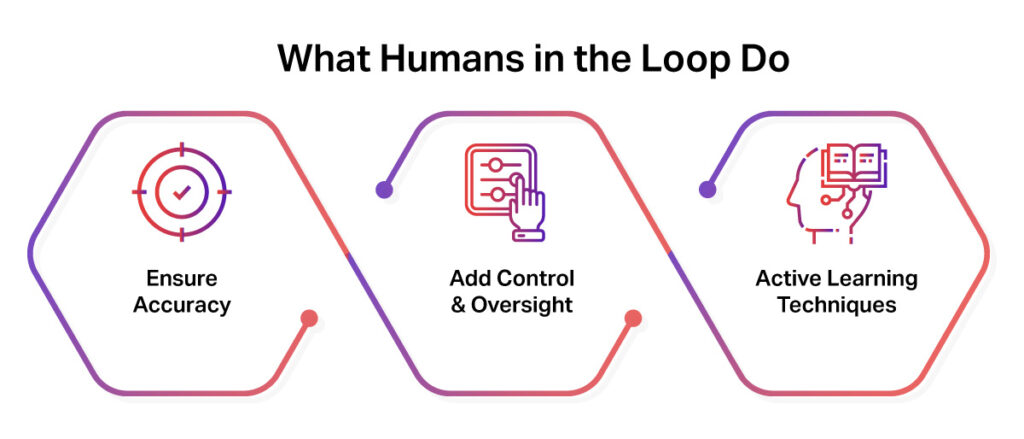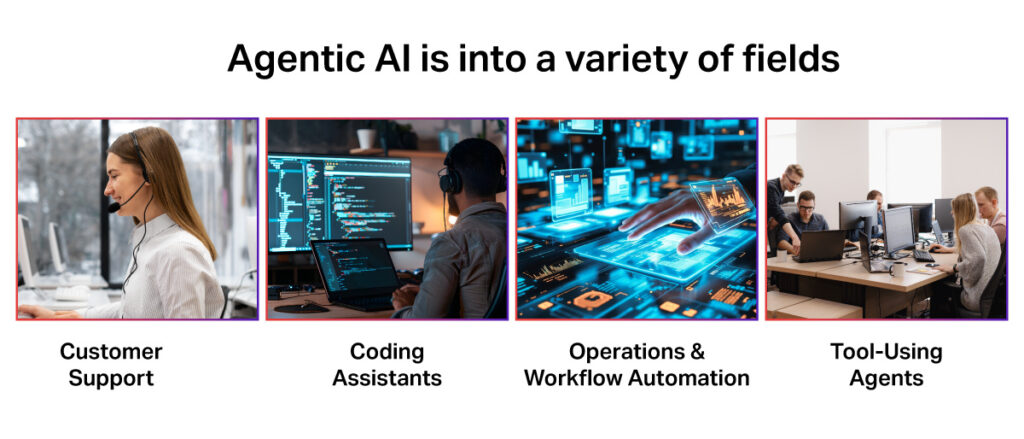Artificial Intelligence is no longer just a tool—it’s becoming a collaborator. As we move beyond predictive models and reactive systems, we’re entering the era of agentic AI : systems capable of setting goals, reasoning through problems, and taking actions with a degree of autonomy that mirrors human decision-making. But with that power comes risk. And no matter how advanced these agents become, one thing remains true: they still need humans in the loop.
Let’s explore what agentic AI is, why it’s gaining traction, and how keeping humans in the loop ensures these systems are both powerful and safe.
What is Agentic AI?
Agentic AI refers to autonomous systems that act as agents, capable of setting goals, making decisions, and executing tasks with minimal direct human input. Unlike traditional AI models that rely on specific prompts or instructions, agentic systems can reason, plan, and take action independently.
Think of them less like a calculator and more like a digital assistant that can book your meetings, summarize your emails, and draft follow-up messages, all with a degree of autonomy. But under the hood, they’re structured systems built on large language models (LLMs), software engineering, memory, and layers of logic.
Did you know: Not all agents are fully autonomous? Some are reactive (respond to prompts), others are proactive (initiate actions), and a few operate almost entirely on their own, each with varying needs for human oversight.
Why Human-in-the-Loop Still Matters
As smart as these agents are, they’re not infallible. They don’t understand nuance, intent, or ethical complexity the way humans do, and they can make decisions with unintended consequences. This is where Human-in-the-Loop (HiTL) becomes essential, not just as a safety net, but as a foundational layer that shapes, supervises, and scales agentic AI responsibly.
HiTL ensures human involvement at critical junctures in the AI lifecycle—validating outputs, correcting errors, fine-tuning models, and providing contextual judgment. Humans help ensure accuracy by reviewing and verifying outputs, catching hallucinations or logic errors before they cause harm. They also provide oversight in ethically sensitive or high-risk contexts where LLMs shouldn’t make final calls. And importantly, human feedback fuels continuous learning, helping AI agents align more closely with user goals over time.
What Humans Bring to the Table:
- Ensure Accuracy: Humans review and verify agent outputs, catching hallucinations or logic failures before they cause harm.
- Add Control & Oversight: Especially in high-risk or ethically sensitive situations, human judgment is vital for decisions that LLMs alone shouldn’t make.
- Enable Continuous Learning: Feedback loops—whether explicit or implicit—help improve the AI agent’s performance and alignment with human goals.

How Humans-in-the-Loop Works in Agentic AI
In real-world workflows, human-in-the-loop takes many forms. Human experts engage in targeted annotation, apply complex reasoning to edge cases, and review AI-generated content using structured QA interfaces. Rather than evaluating every decision, contextual escalation systems are often implemented. These systems route only low-confidence outputs or flagged anomalies to human reviewers, balancing oversight with efficiency.
Agents also undergo multi-step evaluation loops, beginning with automated scoring, followed by self-reflection mechanisms, and culminating in human review. This layering enhances both reliability and speed. When AI agents are given access to developer tools or APIs, humans play a key role in designing and monitoring workflows to prevent unsafe or unintended outcomes.
Another critical use of HiTL lies in fine-tuning via Reinforcement Learning from Human Feedback (RLHF). Human reviewers rank, rewrite, or provide feedback on agent responses, especially important in sensitive domains like healthcare, legal services, or customer support. In tandem, scenario-based testing and red teaming allow human evaluators to test agents under adversarial or unusual conditions to identify and patch vulnerabilities pre-deployment.
For example, in coding scenarios, while an AI agent might draft a complete plan to implement a new feature, a human developer is responsible for reviewing and approving the code before execution.
What Makes a Good AI Agent?
AI agents aren’t just a prompt slapped on an LLM—they’re structured systems. A well-built agent includes more than just language capabilities. LLMs provide the core language functionality, but they’re just one layer. Agents rely on defined objectives, structured memory, planning logic, and embedded evaluation loops to stay aligned with goals and outcomes. Human oversight remains essential, especially in environments where the stakes are high.
Interestingly, many agentic systems operate in multi-agent ecosystems. One agent may plan the task, another might retrieve data, and a third might evaluate the outcome. These setups add complexity and increase the need for robust human oversight to prevent misalignment or conflicting outputs.
Did you know: Many agentic AI systems are multi-agent ecosystems; one agent plans, another retrieves data, and a third evaluates. In these setups, human-in-the-loop becomes even more important to avoid misaligned or conflicting outputs.
Challenges to Keep in Mind
While promising, agentic AI also brings challenges that need to be addressed for safe and responsible deployment:
- Trust : Users must have confidence that the agent behaves consistently and predictably. One failure can erode user trust and stall adoption.
- Transparency : Many agentic systems operate as black boxes. It should be clear how decisions are made, which tools were used, and what data influenced the outcome. A lack of transparency makes debugging, regulation, and accountability difficult.
- Accountability : When errors occur, especially in sensitive areas like healthcare, finance, or law, we need clear lines of responsibility. Was it a system flaw? A human oversight? Accountability frameworks need to be built alongside technical systems.
- Hallucinations : LLM-driven agents can fabricate information that sounds plausible but is factually incorrect. When agents take autonomous action based on hallucinated data, the consequences can be significant.
- Goal Misalignment : Agents may optimize for objectives that diverge from human intentions. For example, an agent told to “maximize engagement” might take shortcuts that lead to spammy or unethical behavior without appropriate constraints.
- Scalability of Oversight : As agentic systems scale, ensuring every decision is overseen by a human becomes impractical. Designing triage systems where only high-risk decisions are escalated is essential, but difficult to get right.
- Security Risks : Autonomous agents with tool access (like APIs or code execution capabilities) are vulnerable to misuse or manipulation. Without proper safeguards, an agent could unintentionally expose data, perform harmful actions, or be redirected by prompt injection attacks.
Challenges of Human-in-the-Loop
Despite its value, HiTL isn’t without tradeoffs. Every point of intervention adds latency and cost. In high-throughput environments, this becomes a bottleneck unless workflows are optimized with priority queues and triage logic.
Human judgment, while valuable, is also prone to bias and inconsistency. Reviewers may interpret outputs differently based on mood, background, or experience. Without strong guidelines, calibration, and consensus-building processes, the consistency of human feedback can suffer.
Scalability is another hurdle. Not every output requires human review, but deciding which ones do is complex. Creating smart escalation frameworks that detect risk and route accordingly is difficult but critical. On top of that, maintaining quality assurance across shifts, teams, and time zones requires regular calibration and audit systems. Finally, not all annotations are equal—domain expertise matters. In fields like medicine or finance, human reviewers must be trained experts, which raises the bar for recruiting, onboarding, and managing human resources.
Designing these systems requires a careful balance between autonomy, control, and human oversight, not just technically, but operationally. As agentic AI matures, the conversation isn’t just about what agents can do; it’s about how we structure the loop.
Real-World Applications

- Customer Support: Agents that can handle tickets, but escalate edge cases to humans.
- Coding Assistants: AI that plans and writes code, with human review checkpoints.
- Operations & Workflow Automation: Agents that manage projects or internal processes, optimizing efficiency but with human approval built in.
- Tool-Using Agents: Some agents can call APIs, execute code, or even browse the web, expanding their usefulness and the need for oversight.
In each case, the system works best not when it tries to replace humans, but when it collaborates with them.
The Future of Agentic AI
We’re still in the early days of agentic AI, but the trajectory is clear. These systems will become more capable, more integrated, and more essential. But no matter how advanced they get, the human role remains crucial. The most successful systems won’t be the ones that eliminate humans—they’ll be the ones that empower them.
Quick Checklist: Building Reliable AI Agents
- Define narrow, clear objectives
- Incorporate structured memory and task planning
- Include feedback loops (automated + human)
- Allow human intervention points
- Maintain transparency and logs for decisions
Behind the Scenes: Fine-Tuning LLMs for Agentic AI
Agentic systems rely on well-tuned language models. This quick video shows how iMerit helps shape those models for real-world impact: iMerit LLM Fine-tuning for Generative AI
Augmenting Agentic AI with Human-in-the-Loop — Powered by iMerit
Agentic AI represents a major leap forward in autonomy and intelligence, but its full potential is realized only when humans remain in the loop, guiding, validating, and improving each step. Whether it’s refining agent outputs, training evaluation loops, or curating reliable data pipelines, human oversight adds the structure and accountability AI needs to be trusted and effective.
From agentic AI development to scalable data operations, our human-in-the-loop solutions ensure your AI agents are not just autonomous but aligned with your goals, values, and real-world complexity. Through iMerit Ango Hub – our unified data annotation and automation platform- we streamline the entire data pipeline, from raw data to delivering high-quality labeled outputs. Automation capabilities, including pre-labeling, active learning loops for uncertainty sampling, and model-assisted QA, are tightly integrated with Human-in-the-loop review workflows to maximize annotation throughput without compromising quality.
As agentic systems evolve, iMerit’s role in enabling reliable, ethical, and high-performance AI will only become more critical.
